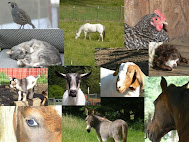Thanks for joining me on my series of posts about our daughter, H-Bob, and our discovery of her dyslexia and the effects of her diet. If you'd like, here are links to parts one, two, and three. Read along and find out how we took the first steps to evaluate and tackle major changes to our diet.
August 2011
Well...we bit the bullet. H-Bob and I were going to attempt to eliminate gluten, dairy and sugar from our diets. Just to see what might happen. Although most professionals...and remember, I'm not one--just a investigative type of mom...recommend at least a six week period of avoiding these foods, I was just hopeful to pull it off for two weeks. How could one exist without these food? What would you eat? The whole concept was very intimidating and daunting to me. That shows you just how entrenched we were in our standard American diet (SAD). The clincher that gave me the determination to see this through was that as I flipped back through her food journal, I could see the relationship of what she was eating to her outward actions.
Nevertheless, just the thought of eliminating these foods from our diet made ME panic. Why was I so worried? I could go back to eating the same old way anytime, right? The next week was the WORST of our lives. I can truthfully say that the two of us went through withdrawals that must be equal to anyone dealing with an addiction. I did not go through the cupboards and throw out the offending foods as there were four other family members who absolutely did not want to be involved in this experiment. But, oh, I wish I could have. To walk by the bread and butter. To not have milk in my coffee. No pasta. Not even any steel cut oats. Processed foods were out of the question as they usually had sugar. I thought I was going to die. And H-Bob basically did. There were tears and crying and yelling and screaming. But by the end of the week, something remarkable happened.
Our intense obsession over these foods was over. The storm of sorts was gone. And we did survive. Not only survived, but H-Bob was feeling good. Those unpredictable, daily multiple meltdowns were oh-so drastically reduced. I will admit though, it did not have a perfect ending. I couldn’t keep H-Bob on that strict diet any longer than about ten days. I caved. Perhaps if I wasn’t trying to support her and eliminate the same foods from my diet at the same time, I could have kept up my resolve. But it didn’t happen. So I allowed her to choose…gluten or dairy to add back in. She chose dairy, thankfully, and we marched on for a second week without gluten.
Then I began to start noticing other things. H-Bob’s several times a week ankle joint pains were a thing of the past. Her tic was gone. She smiled a lot more...was more aware of things around her...and seemed to have a veil or fog lifted from her being. She flew through her vision exercises. The roller-coaster emotions disappeared. All those things that made her life stressful were falling away. Maybe all those glowing reports by other parents whose children were on a gluten-free diet were accurate after all. Now let me say here again before I forget...I am not a doctor or a researcher or a professional of any kind. I’m not making a suggestion that you or anyone else you know can follow in our footsteps and experience the same results. But just the same, I want to
SHOUT ALL OF THIS FROM THE ROOFTOPS.
It really did work for H-Bob. Now after that required announcement, back to the diet thing. I was becoming a believer in gluten intolerance. Dairy did not seem to produce any undesirable effects. Sugar, on the other hand, seemed to exacerbate things but not on the level it was.
Another aspect that I was delving in to was that of fatty acid supplementation. Although limited, there is research to support that many kids on the spectrum scale are found to be deficient in omega 3 EPA/DHA. Effects from this supplementation do not appear as quickly as a diet change and sometimes take up to a month before any positive results are seen. But I was still looking for a missing component and this could be it. H-Bob’s GF diet had eliminated many of the mood and attention issues but there were still the issues of the way her brain seemed to have difficulties in processing information. We noticed that short term memory was pretty non-existant. ADHD anyone? She seemed completely inable to visualize anything internally. Part of these issues her vision therapist commented would be addressed after her vision abilities stabilized to where they should be. So we added an omega 3 supplement that had roughly equal parts EPA and DHA in it.
We were seeing such great improvement in other areas that I became a firm believer in everything else that naturopaths and other doctors of functional medicine had been using to help autistic, ADHD, and dyslexic children. So there were a couple of other things we did during this time. I began H-Bob on a probiotic as I became aware of the leaky gut syndrome that can cause autoimmune reactions to gluten in the form of her leg pains. We also added in a complete children’s vitamin. I have never felt totally secure in the fact that those gummy-type children’s vitamins actually are very potent, and due to her nutritional deficiencies (caused by her limited diet and malabsorption by her leaky gut) I tracked down a powdered vitamin recommended by Dr. Mark Hyman, author of The UltraMind Solution, whose nutritional advice was invaluable in helping to understand the dietary changes we needed to make.
We were probably four to five weeks into these supplements and noticing that none of the other negative symptoms were returning. Besides that, there started to appear additional unexpected benefits. One day while working on her eye therapy practice work, H-Bob startled me by exclaiming that something ‘switched on’. She was so excited she could hardly explain it to me, but while working on her divergence and convergence exercise she said that her ability to cross and uncross suddenly ‘turned on’. Something she had struggled to overcome since the beginning of her eye therapy. From that point on, she was 100% able to complete those exercises. Her therapist could hardly believe the improvement she made that week. We noticed that she could grasp the meaning of numbers while working on math. Her thinking skills were improving as well. Everything was moving along on an inclining scale upwards.
But then, life took over. DH had a fishing trip scheduled with a buddy and his kids. They were to spend an extended weekend camping. Cooking their guy food. Buying treats. All the bad stuff. I tried my best to convince DH that gluten was out of the question but knew that he didn’t really see the day-to-day effects that her new food choices were having on her. The day they came home, H-Bob bounded into the house with a red licorice rope in one hand and a soda in the other. Oh my. It wasn't long until it was all too clear that there was a diet connection here. After a miserable couple of days getting her back onto track, we were once again back to gluten free.
This was definitely a turning point in H-Bob's life. From here on we experienced positive gains. But our journey was far from over. School was about to start. Would any of these changes be evident once structured learning took over again? That will be the topic of Part Five.

 |


.jpg)















+(2).jpg)


